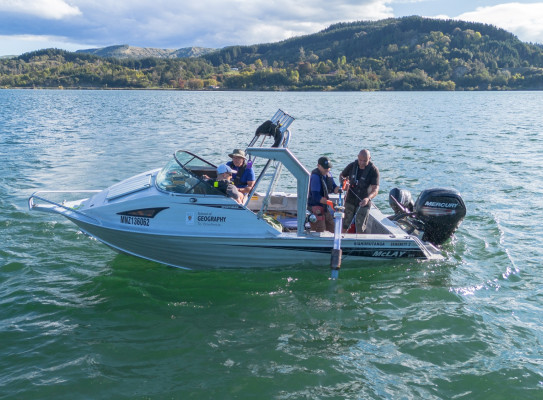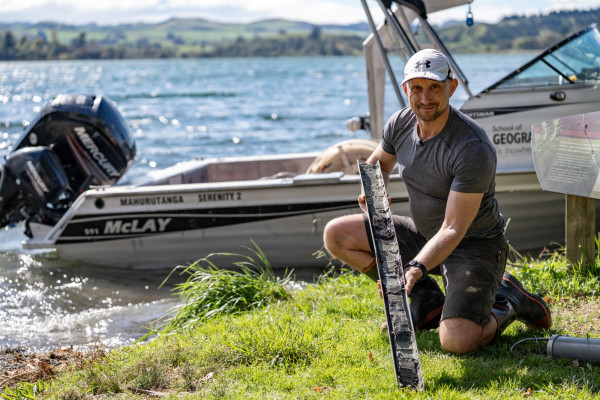Casting for core to strengthen lakes’ resilience to extreme climate events

Layers of mud on the bottom of Hawke’s Bay’s lakes are a hidden archive of the impacts of Cyclones Gabrielle and Bola on the lakes’ ecosystems, holding vital insights to shape lake management and restoration in the face of increasing extreme weather.
Scientists from the Our Lakes, Our Future research programme are studying sediment from Lakes Tūtira and Waikōpiro, to understand the response and recovery of lake ecosystems to the cyclones, and potential land-use strategies to buffer future impacts.
Lake ecosystems choked by cyclone silt and mud
When extreme events, such as Cyclone Gabrielle in 2023, lash the landscape with heavy rain, landslides and erosion in the hills carry a huge volume of silt and mud into surrounding streams. This sediment eventually washes into lakes, causing large disturbances to the aquatic plants, animals and organisms living there.
As well as smothering important māhinga kai populations, such as kākahi (freshwater mussels), the sediment brings nutrients from the landscape – nitrogen and phosphorous – that can cause algal blooms and severe environmental effects.
The flow of sediment into lakes can be prolonged, with the landslides that were triggered in the surrounding catchments continuing to provide a source of increased sediment during rainfall, long after the cyclone has passed.
With the frequency and severity of storms projected to intensify under climate change, understanding how these events impact lake ecosystems is key for safeguarding lakes, so that we can continue to enjoy them for recreation, gather food from them, and protect their cultural value into the future.
Tracing cyclone impacts back through time at Lakes Tūtira and Waikōpiro
Lakes Tūtira and Waikōpiro sit side-by-side in north-eastern Hawke’s Bay and provide a unique case study for research into extreme climate impacts. In addition to Cyclone Gabrielle, the lakes were also impacted by Cyclone Bola in 1988, with the record of the lakes’ response to this historical event preserved in the lakebed sediment.
Our Lakes, Our Future team members from GNS Science, Te Herenga Waka – Victoria University of Wellington, Otago University and Waka Tuarua carried out fieldwork at the lakes in April. They retrieved 10 sediment cores, ranging between 1.5 to 6 metres in length, and collected sediment samples from automated traps that sit on the lakebed collecting monthly samples.
A range of analytical techniques such as sedimentary eDNA (environmental DNA) and examination of the remains of organisms trapped in the sediment, will be used to build an understanding of the organisms that were present, from bacteria through to algae, insects, fish and plants, and how the populations have changed through time.
Jamie Howarth, Our Lakes Our Future researcher and Associate Professor at Te Herenga Waka – Victoria University of Wellington, says that when sediment is mobilised and washed into the lake during an extreme storm, it forms an easily identifiable deposit in the sediment core.
“We look at the sediment that accumulated before and after the weather event, and what was happening in the lake ecosystem. Through this comparison we can understand how long the lake ecosystem remains disturbed, and how long it takes to recover.”


Informing future lake restoration and management
Initial observations from the cores underscore the importance land-use practices can play in mitigating or amplifying the effects of extreme climate events.
The cores show that during Cyclone Bola, a similar amount of sediment accumulated in both Tūtira and Waikōpiro. However, during Cyclone Gabrielle much less sediment entered Waikōpiro in comparison to Tūtira. The team suspect that this difference is due to changes in the catchment around Waikōpiro – while Tūtira remains largely in pasture, in the years following Cyclone Bola, Waikōpiro was planted in Manuka, and wetlands were restored where the stream enters the lake. These actions may have helped trap the sediment and prevented it entering Waikōpiro in such large amounts or dissipated the impact of extreme rainfall on the soils.
The team will use the data gleaned from the sediment cores to help test and refine models, to forecast how lakes ecosystems will fare in our changing climate.
The models will be a really vital management tool for understanding what restoration practices we need to do to ensure that these taonga, these amazing lakes, are resilient into the future.
-
Developing a holistic approach to lake management
Other lakes across the country are also part of the study, filling in different parts of the puzzle about lake response to extreme climate events. The researchers will examine the effect of catchment size on lake response, using Hawke’s Bay’s Putere Lakes. Another extreme weather event some lakes will face is drought, and the team will focus on lakes in Marlborough to understand how those lake ecosystems are impacted by drought.
At Lakes Tūtira and Waikōpiro, Maungaharuru Tangitū are partners in the research, sharing their knowledge and observations of how the lake ecosystems have changed from their perspective, and their aspirations for lake restoration.
Marcus Vandergoes, GNS Science Principal Scientist and Our Lakes, Our Future Co-lead, says that the extreme climate research is an important part of the programme’s wider work to develop holistic understandings and approaches for lake management.
“We’re developing a greater understanding around cultural indices, values, and the susceptibility of lakes to stressors, including extreme climate events. We’re using all of that information to build frameworks to better manage these lakes into the future.”
-
Our Lakes, Our Future funders and collaborators
Our Lakes, Our Future is funded by the Ministry of Business, Innovation and Employment 2023 Endeavour Fund.
The programme is co-led by GNS Science, Lincoln University, and the Cawthron Institute, with iwi partners Manawhenua Ki Mohua, Ngāti Hauiti and Ngā Puna Rau o Rangitīkei, Te Arawa Lakes Trust and Ngāti Pāhauwera, research partners University of Waikato, Te Herenga Waka – Victoria University of Wellington, University of Otago, Matana Consulting, Waka Tuarua Ltd and stakeholders from regional and central government.
International partners include Griffith University, Northern Arizona University, Queen's University, Wright State University, UK Centre for Ecology & Hydrology, University of Canberra, Wageningen University and Research.
The extreme climate research at Lake Tūtira and Lake Waikōpiro is delivered in partnership with Maungaharuru-Tangitu Trust and Hawke’s Bay Regional Council.